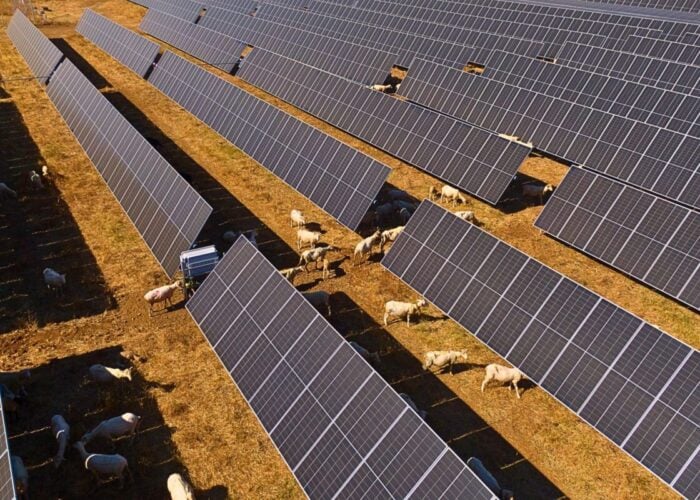
Solar Module Super League (SMSL) member LONGi Green Energy shipped 39.62GW of monocrystalline silicon wafers, of which 20.15GW was sold externally and 19.47GW for internal use, according to its financial results for the first half of the year.
Shipments of monocrystalline modules reached 18.02GW, of which 17.7GW was sold externally (including 87.35MW of BIPV modules) and 0.32GW was for self-use.
Unlock unlimited access for 12 whole months of distinctive global analysis
Photovoltaics International is now included.
- Regular insight and analysis of the industry’s biggest developments
- In-depth interviews with the industry’s leading figures
- Unlimited digital access to the PV Tech Power journal catalogue
- Unlimited digital access to the Photovoltaics International journal catalogue
- Access to more than 1,000 technical papers
- Discounts on Solar Media’s portfolio of events, in-person and virtual
The company said that import restrictions such as the Withhold Release Order (WRO) on silicon products from Hoshine Industries and its subsidiaries in the US had led it to adjust its operating strategy, “shifting the focus of sales to other key markets such as Europe”.
It referenced increased deployment targets in the European Union (EU) and India as key opportunities for the company moving forward, noting the EU’s upgraded REPowerEU plan and that the “Indian market imported almost as many modules in the first quarter alone as it did throughout the entirety of 2021.”
Moreover, according to the announcement, LONGi achieved an operating revenue of RMB50.417 billion (US$7.35 billion) in the first half of the year, a year-on-year (YoY) increase of 43.64%, while its net profit was RMB6.48 billion (US$940 million), up by 29.79% YoY. Net profit deducted from non-recurring gains and losses attributable to shareholders was RMB6.405 billion (US$930 million), up by 30.58% YoY.
TOPCon ‘transitionary’
In the interim report, LONGi published information on its new cell technology for the first time.
LONGi said: “The company has developed and reserved a variety of new cell and module technologies, seeking breakthroughs in the n-type TOPCon, p-type TOPCon, n-type HJT and p-type HJT and other highly-efficient cell technologies, and also has developed a Hybrid Passivated Back Contact (HPBC) cell.”
The company said it will continue to promote the mass production and transformation of new highly-efficient cells and modules on the basis of good cost-performance and commercialisation in order to build a differentiated product portfolio with long-term competitiveness.
LONGi is currently providing silicon wafers to facilitate new cell technology research as well as equipment and supporting materials as a guarantee for technical reserve and mass production when breakthroughs occur.
Previously, Zhenguo Li, president of LONGi, mentioned in a public report that the theoretical maximum efficiency of mono silicon cells is 29.4%, the laboratory limit efficiency is 28%, and the mass production efficiency is 26-27%. LONGi has been looking for the path to reach 26%-27% with lower cost and is progressing well with the plans.
In terms of TOPCon, HJT and other n-type technologies, Li said LONGi believed TOPCon technology would be transitional because its highest possible efficiency is just 1% greater than current technologies, adding that HPBC technology has more room for improvement when it comes to cell efficiency.
LONGi’s reported that its HPBCcapacity in Xixian, Henan province was originally 15GW but this has now been increased to 29GW. With 4GW in the city of Taizhou and 5GW in Yinchuan, the totally planned HPBC capacity exceeds 40GW, with production expected to start in Q4.
Li said that when the company reaches a full capacity of HPBC in 2023, it will ship 20-25GW of products per year. The HPBC technology will replace part of the company’s PERC products in the future distributed market. However, PERC products will still occupy a market share in special or low-end markets.
Inner Mongolia supply chain buildout
At the same time, LONGi is building out its supply chains in Inner Mongolia for the first time, including a 46GW mono silicon ingot facility, a 30GW high-efficiency mono cell project and 5GW module project in Ordos Zero-carbon Industrial Park. Equipment at LONGi’s Ordos projects will be installed by the end of Q2 2023.
Many Chinese companies have been building out their supply chains in Inner Mongolia in response to import restrictions in the US and other leading markets that accuse companies operating in the region of Xinjiang of using forced labour to create some of their products.
Meanwhile, China’s Photovoltaic Industry Association has said that the global PV market development may be accelerated with expected instalments of 205-250GW for this year, of which 85-100GW will be in China.
LONGi said that its mono silicon wafer shipment target for 2022 is 90GW-100GW (including self-use), while its module shipment target stood at 50GW-60GW (including self-use) and the annual target of operating revenue is RMB100 billion (US$14.58 billion) or more.







